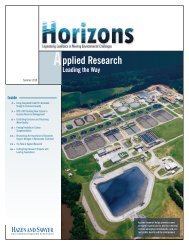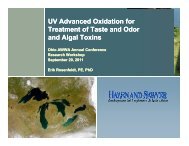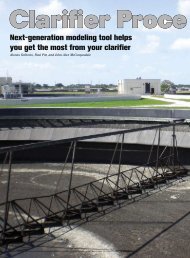Download Horizons Winter 2007 Issue - Hazen and Sawyer
Download Horizons Winter 2007 Issue - Hazen and Sawyer
Download Horizons Winter 2007 Issue - Hazen and Sawyer
Create successful ePaper yourself
Turn your PDF publications into a flip-book with our unique Google optimized e-Paper software.
Partnership Making Progress Protecting Long Isl<strong>and</strong> Sound<br />
By Paul D. Saurer, P.E., Vice President <strong>and</strong> Richard Panchyk, N.E. Marketing Manager<br />
Located between the north shore of Long Isl<strong>and</strong> <strong>and</strong> the<br />
south shore of Connecticut, the Long Isl<strong>and</strong> Sound is a<br />
unique estuary. Roughly 1,320 square miles in area, more<br />
than 20 million people live within 50 miles of the Sound,<br />
<strong>and</strong> the area contributes over $5 billion a year to the local<br />
economy through tourism <strong>and</strong> recreation.<br />
The Long Isl<strong>and</strong> Sound is also an important habitat for<br />
thous<strong>and</strong>s of species of birds, fish, <strong>and</strong> other wildlife. The<br />
mixing of salt water from the ocean <strong>and</strong> fresh water draining<br />
from the l<strong>and</strong> serves as a breeding, feeding, <strong>and</strong> nursery<br />
area for several<br />
sensitive <strong>and</strong> threatened<br />
species. The<br />
federal government<br />
officially designated<br />
Long Isl<strong>and</strong> Sound as<br />
an “estuary of national<br />
significance” in<br />
1987. However, water<br />
pollution from the<br />
highly urbanized tristate<br />
area threatens<br />
the Sound.<br />
The good news is<br />
that there are practical<br />
solutions to these<br />
problems, <strong>and</strong> <strong>Hazen</strong><br />
<strong>and</strong> <strong>Sawyer</strong> <strong>and</strong> its<br />
clients are at the forefront<br />
of efforts to<br />
clean up Long Isl<strong>and</strong><br />
Sound. From initial research into the nature of the Sound’s<br />
water quality issues, to selection of Biological Nutrient<br />
Removal as the key technology — <strong>and</strong> culminating with<br />
the management <strong>and</strong> oversight of over $640 million in<br />
capital construction — the firm has been, <strong>and</strong> will continue<br />
to be, a leader in nutrient removal.<br />
Long Isl<strong>and</strong> Sound’s Hypoxia Crisis<br />
Most aquatic species require dissolved oxygen in the<br />
water for respiration, but nitrogen — from both point<br />
sources (such as wastewater treatment plants) <strong>and</strong> nonpoint<br />
sources (such as stormwater runoff) — can deplete<br />
dissolved oxygen.<br />
Excessive nitrogen in the water provides a food source<br />
for algae growth. When the algae die, the decomposition<br />
of this organic matter by bacteria consumes available dissolved<br />
oxygen, limiting what’s available for fish <strong>and</strong> other<br />
higher forms of marine life. This depletion of available<br />
dissolved oxygen in the water is most evident during the<br />
warm summer months, when the rate of consumption of<br />
oxygen can be greater than that at which it is replenished.<br />
Low dissolved oxygen levels (or hypoxia) cause immobile<br />
species to die off <strong>and</strong> others to avoid the hypoxic<br />
waters, transforming what should be a thriving ecosystem<br />
into a depleted waterbody.<br />
Through the 1970s<br />
<strong>and</strong> 1980s, nitrogen<br />
discharges from both<br />
point <strong>and</strong> nonpoint<br />
sources to Long<br />
Isl<strong>and</strong> Sound were<br />
unregulated <strong>and</strong><br />
increased at an<br />
alarming rate through<br />
the continued<br />
development of<br />
surrounding communities,<br />
exacerbating<br />
hypoxic conditions in<br />
the Sound.<br />
Partnership Works<br />
Towards Solutions<br />
To address this issue,<br />
a bi-state partnership<br />
called the Long<br />
Isl<strong>and</strong> Sound Study<br />
(LISS) was authorized by Congress <strong>and</strong> founded in 1985.<br />
The partnership of user groups, federal, state, <strong>and</strong> local<br />
agencies, <strong>and</strong> other organizations <strong>and</strong> individuals, undertook<br />
an extensive examination of the various environmental<br />
issues confronting the Sound <strong>and</strong> developed nitrogen<br />
reduction goals for the surrounding municipalities.<br />
Although water quality in the Long Isl<strong>and</strong> Sound has been improving, dissolved oxygen levels crept back<br />
up this summer as treatment plants are being upgraded. Data used with the permission of the Connecticut<br />
Department of Environmental Protection, Long Isl<strong>and</strong> Sound Water Quality Monitoring Program.<br />
The LISS determined that more than half of the nitrogen<br />
in the Sound was attributable to effluent from nearby<br />
wastewater treatment plants — there are 105 wastewater<br />
treatment plants in Connecticut <strong>and</strong> New York that,<br />
according to 2006 estimates, discharge roughly 160,000<br />
pounds of nitrogen into the Sound daily.<br />
Continued on Page 6<br />
4








